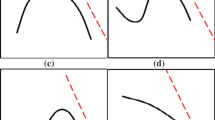Abstract
In order to amend the superficial performance of palygorskite and improve its application, the natural palygorskite(NP) was treated in the dipping and ionic exchanging experiments using 6 mol/L hydrochloric acid treatment. The performance and pore structure of the treated palygorskite(TP) were investigated by means of microscope analyses, FT-IR, XRF, BET-SSA and full hole distribution analytical techniques. The results show that the hydrochloric acid treatment can make the gracile and aggregating compact crystal bundles inside palygorskite clay broken and dispersed, the roughness of microcrystalline surface increases, which not only can dissolve or remove dolomite but vary the superficial performance of palygorskite to some degree. The specific surface area and pore volume increase a lot, while the mean pore size decreases. The pore structure of TP changes remarkably compared with that of NP after 6 mol/L hydrochloric acid treatment, and the relevant physicochemical performance can be improved.
Similar content being viewed by others
References
Murray H H. Traditional and new applications for kaolin, smectite, and palygorskite: a general overview [J]. Applied Clay Science, 2000, 17(5–6): 207–221.
Singer A. Dissolution of Australian palygorskite in dilute acid[J]. Clays and Clay Minerals, 1977, 25(2): 126–130.
Corma A, Mifsud A, Sanz E. Influence of the chemical-composition and textural-composition and textural characteristics of palygorskite on the acid leaching of octahedral cations[J]. Clay Minerals, 1987, 22(2): 225–232.
Corma A, Mifsud A, Sanz E. Kinetics of the acid leaching of palygorskite: Influence of the octahedral sheet composition[J]. Clay Minerals, 1990, 25(2): 197–205.
Gonzalez F, Pesquera C, Benito I. Thermal investigation of acid-activated attapulgites: influence of isomorphic substitution in the octahedral sheet[J]. Thermochimica Acta, 1992, 194(2): 239–246.
Gonzalez F, Pesquexa C, Benito I, et al. Mechanism of acid activation of magnesium palygomkite[J]. Clays and Clay Minerals, 1989, 37(3): 258–262.
Barrios M S, Gonzalez L V F, Rodriguez M A V, et al. Acid activation of a palygorskite with HCl: Development of physicochemical, textural and surface-properties[J]. Applied Clay Science, 1995, 10(3): 247–258.
YANG Liu-qing. Study on chinese attapulgites[J]. Journal of University of Science and Technology of Jiangsu, 1995, 16(1): 58. (in Chinese)
Augsburger M S, Pedregosa J C, Strasser E, et al. FITR and Mossbauer investigation of a substituted palygorskite: Silicate with a channel structure[J]. Journal of Physics and Chemistry of Solids, 1998, 59(2): 175–180.
Pozas M, J. M. In difractión de muestras policristalinas[D]. Valladolid: University of Valladolid, 1975.
Melo D M A, Ruiz J A C, Melo M A F, et al. Preparation and characterization of terbium palygorskite clay as acid catalyst [J]. Microporous and Mesoporous Materials, 2000, 38(2–3): 345–349.
Lynwood H W, Schwint I A. Attapulgite, its properties and application[J]. Industrial and Engineering Chemistry, 1967, 59(9): 58–69.
Farmer V C. The Infrared spectra of minerals[M]. London: Mineralogical Society, 1974.
Bain D C, Fraser A R. An unusually interlayered clay mineral from the eluvial horizon of a humus-iron podzol[J]. Clay Minerals, 1994, 29(1):69–76.
Huang C K, Keer P F. Infrared study of the carbonate minerals[J]. American Mineralogist, 1960, 45: 311–324.
Girgis B S, Yunis S S, Soliman A M. Characteristics of activated carbon from peanut hulls in relation to conditions of preparation [J]. Materials Letters, 2002, 57(1): 164–172.
YAN Ji-min, ZHANG Qi-yuan. Adsorption and coacervation: solid surface and pore[M]. Beijing: Science Press, 1979. (in Chinese)
CHEN Tian-hu. Nanometer scale mineralogy and geochemistry of palygorskite clays in the border of Jiangsu and anhui provinces[D]. Hefei: School of Resources and Environmental Engineering, Hefei University of Technology, 2003. (in Chinese)
Gregg S J, Sing K S W. Adsorption, surface area, and porosity[M]. London: Academic Press, 1982.
Author information
Authors and Affiliations
Corresponding author
Additional information
Foundation item: Project(10200202002) supported by the National Tobacco Monopolistic Bureau of China; project(40473006) supported by the National Natural Science Foundation of China; project(2006KJ010A) supported by the Natural Science Key Research Foundation of Anhui Province
Rights and permissions
About this article
Cite this article
Liu, Yx., Dai, Ww., Wang, T. et al. Superficial performance and pore structure of palygorskite treated by hydrochloric acid. J Cent. South Univ. Technol. 13, 451–455 (2006). https://doi.org/10.1007/s11771-006-0066-9
Received:
Accepted:
Issue Date:
DOI: https://doi.org/10.1007/s11771-006-0066-9
Key words
- palygorskite
- hydrochloric acid treatment
- BET-specific surface area
- full pore distribution
- adsorption-desorption isotherms




